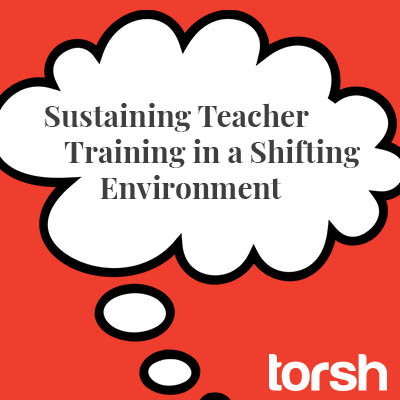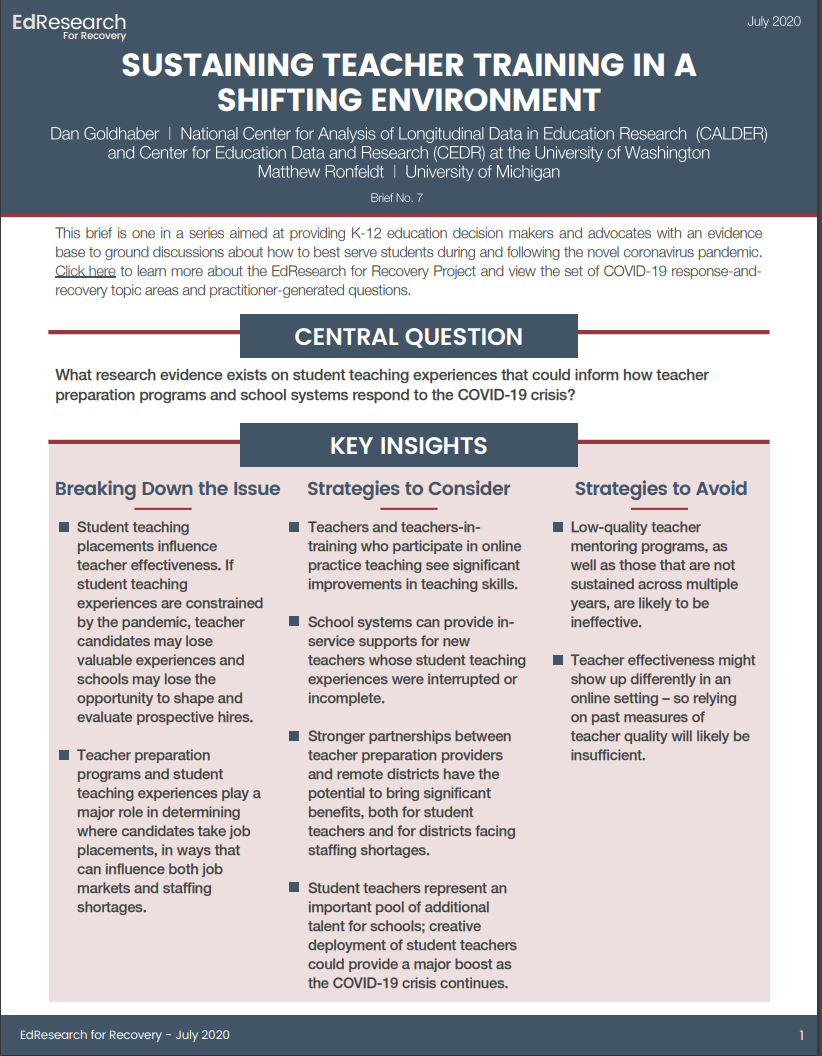On July 23, 2020, the Annenberg Institute for School Reform at Brown University released “Sustaining Teacher Training in a Shifting Environment”, one in a series of research briefs addressing the key issues pertaining to the impact of COVID-19, this one specifically on teacher training and professional development. The brief series, created by the EdResearch for Recovery Project, aims to provide K-12 education decision-makers and advocates with a source for research-based discussions about how to best serve students during and following the COVID-19 pandemic.
The authors of the paper, Dan Goldhaber (National Center for Analysis of Longitudinal Data in Education Research (CALDER) and Center for Education Data and Research (CEDR) at the University of Washington) and Matthew Ronfeldt (University of Michigan) provide insights and strategies to support professional development through the use of virtual training and mentoring, along with other tactics to minimize the teacher shortage that was already an issue prior to the pandemic.
As a former educator in public and charter schools, with experience on the policy side of education, and now in my role at Torsh working with Higher Ed Teacher Prep programs, I found this brief to be especially relevant in current times. After discussing with colleagues our thoughts on the topic, I wanted to share some highlights from those conversations and from my own experiences.
Goldhaber and Ronfeldt break down the issue into two segments:
- Student teaching placements influence teacher effectiveness. If student teaching experiences are constrained by the pandemic, teacher candidates may lose valuable experiences and schools may lose the opportunity to shape and evaluate prospective hires.
- Teacher preparation programs and student teaching experiences play a major role in determining where candidates take job placements, in ways that can influence both job markets and staffing shortages.
Prior to the pandemic, there was already a teacher shortage in the United States, which is on its way to becoming a full-blown crisis. In a list of facts about the teaching profession compiled by the U.S. Department of Education, 50% of new teachers leave the profession within five years., Many teachers have made the decision to opt-out of teaching this year (for a variety of reasons, but health concern is a repeat topic). We cannot afford to interrupt the pipeline of new teachers nor can we afford to put under-prepared teachers in classrooms if we are going to ensure that future generations have the access to the high-quality education that they deserve. Student-teachers need field experience and educator preparation programs need to feel confident in the quality of the coaching and mentoring that their students in the field will continue to receive, without having concern around sending observers into classrooms. This is where technology comes into play.
Technology for Teachers in Training
One of the main strategies the brief recommends for tackling the current issue is online practice. According to the research, “teachers and teachers-in-training who participate in online practice teaching see significant improvements in teaching skills.” From seasoned veterans to bright-eyed graduates, all teachers are being asked to fundamentally change the way that they manage their classroom and deliver content, and there is strength in seeking help and practicing new skills to ensure teachers are prepared for their students.
With the abundance of available technology, from TORSH Talent to Nearpod and beyond, teachers can practice executing remote lessons and then share those lessons with their peers for feedback. Even if a school does not have a traditional coaching structure, it is vital to use the available tools to facilitate cooperation and collaboration as everyone tries to tackle new problems.
Coaching Remains Critical
The authors also emphasize that school systems can strategize by “[providing] in-service supports for new teachers whose student teaching experiences were interrupted or incomplete.” As mentioned in the brief, effective mentoring will be determined by the quantity and duration of the mentoring, and the qualifications of the mentor teachers. Again, this is where technology plays an essential role. Tools that facilitate full coaching structures can allow programs to provide aligned feedback to teachers and work to norm and develop mentors and coaches for both in-person and remote environments in a way that does not cause disruption, regardless of geographical constraints.
Two more insights that Annenberg points out around strategies to consider are that “stronger partnerships between teacher preparation providers and remote districts have the potential to bring significant benefits…for districts facing staffing shortages” and “student teachers present an important pool of additional talent for schools, [so] creative deployment of student teachers could provide a major boost as the COVID-19 crisis continues”
When I participated in Johns Hopkins’ online Masters of Education, I saw firsthand how universities are expanding their reach to attract students beyond the traditional confines of geography. Remote tools like those used by Johns Hopkins’ online learning program reaches and serves students in all 50 states. Partnerships between teacher preparation providers and remote districts are not only beneficial for potential increased staffing but also for learning best-practices; K-12 schools can leverage their connections with universities to learn from professors who have experience delivering remote instruction.
Adapting for Success
It is important to note that we must avoid certain strategies as well when tackling these issues. All programs must be adapting right now to support teachers in this new environment. If you are not adapting, then you, your teachers, and your students are falling behind. Now, more than ever, we cannot waste time and resources on strategies that do not work. This brief highlights the following insights on strategies to avoid:
- Low-quality teacher mentoring programs, as well as those that are not sustained across multiple years, are likely to be ineffective.
- Teacher effectiveness might show up differently in an online setting – so relying on past measures of teacher quality will likely be insufficient.
How schools at all levels, from early education through K-12, and up to universities, support educators during this contentious time will have long-term effects on their ability to hire and retain educators, and on student success. Considering strategies that can support teacher training during this time, and maximizing benefits using technology, can help sway these long-term effects in the right direction.

Andy Webber serves as the Business Development Manager focusing on our Higher Education clients at Torsh. Andy, a former teacher, holds a B.A. in International Relations from the University of Texas and an M.S. of Education from Johns Hopkins University (where he first used TORSH as an educator). Andy is excited to combine his experience as an educator and as a TORSH user to deliver individually tailored packages that meet the needs of Higher Education clients’ to improve educational outcomes for all students.





